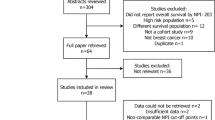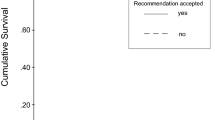Abstract
Background and aim
Especially in malign diseases, the therapeutic decision depends on the prognosis for the individual patient. A prognosis is a prediction of the future course of disease following its onset. Graphical representation of such statistical results—such as the well-known Kaplan–Meier curve—is often used to assist readers of a paper in the interpretation. However, mistakes and distortions frequently arise in the display and interpretation of survival plots. This review aims to highlight such pitfalls and provide recommendations for future practice.
Methods
Special topics are discussed: the criteria for the presentation of the survival curve, the problem of missing values, estimation of the prognosis in the presence of competing risks, comparison of treatment effects and analysis of survival by tumour-response category.


Similar content being viewed by others
References
Kaplan EL, Meier P (1958) Nonparametric estimation from incomplete observations. J Am Stat Assoc 53:457–481
Altman DG, De Stavola BL, Love SB, Stepniewska KA (1995) Review of survival analyses published in cancer journals. Br J Cancer 72:511–518
Bonenkamp JJ, Hermans J, Sasako M, van de Velde CJ (1999) Extended lymph-node dissection for gastric cancer. Dutch Gastric Cancer Group. N Engl J Med 340:908–914
Hartgrink HH, van de Velde CJH on behalf of the Dutch Gastric Cancer Group (2003) Final results of the Dutch D1 versus D2 gastric cancer trial. In: Santoro E, Garofalo A (eds) Proceedings of the 5th World Gastric Cancer Congress. International Gastric Cancer Congress (ROM)
Bollschweiler E, Schneider PM, Monig SP, Altendorf-Hofmann A, Mansmann U, Lehmacher W, Schlag PM, Merkel S, Hohenberger W, Izbicki JR, Hermanek P, Holscher AH (2003) Prognostic relevance of biological and molecular markers in oncology. Criteria for planning and interpreting studies. Chirurg 74:139–144
Pocock SJ, Clayton TC, Altman DG (2002) Survival plots of time-to-event outcomes in clinical trials: good practice and pitfalls. Lancet 359:1686–1689
Brookmeyer R, Crowley J (1982) A confidence interval for the median survival time. Biometrics 38:29–41
Shuster JJ (1991) Median follow-up in clinical trials. J Clin Oncol 9:191–192
Kalbfleisch JD, Prentice RL (1980) The statistical analysis of failure time data. Wiley, New York
Clark TG, Altman DG, De Stavola BL (2002) Quantification of the completeness of follow-up. Lancet 359:1309–1310
Cantor AB, Shuster JJ (1992) Parametric versus non-parametric methods for estimating cure rates based on censored survival data. Stat Med 11:931–937
Andersen J, Goetghebeur E, Ryan L (1996) Missing cause of death information in the analysis of survival data. Stat Med 15:2191–2201
Flehinger BJ, Reiser B, Yashchin E (2002) Parametric modelling for survival with competing risks and masked failure causes. Lifetime Data Anal 8:177–203
Brookmeyer R, Curriero FC (2002) Survival curve estimation with partial non-random exposure. Stat Med 21:2671–2683
Koscielny S, Thames HD (2001) Biased methods for estimating local and distant failure rates in breast carcinoma and a "commonsense" approach. Cancer 92:2220–2227
Gelman R, Gelber R, Henderson IC, Coleman CN, Harris JR (1990) Improved methodology for analyzing local and distant recurrence. J Clin Oncol 8:548–555
Anderson JR (2001) Commonly misused approaches in the analysis of cancer clinical trials. In: Crowley J (ed) Handbook of statistics in clinical oncology
Weiss GB, Bunce H, Hokanson JA (1983) Comparing survival of responders and nonresponders after treatment: a potential source of confusion in interpreting cancer clinical trials. Control Clin Trials 4:43–52
Anderson JR, Cain KC, Gelber RD (1983) Analysis of survival by tumor response. J Clin Oncol 1:710–719
Anderson JR, Cain KC, Gelber RD, Gelman RS (1985) Analysis and interpretation of the comparison of survival by treatment outcome variables in cancer clinical trials. Cancer Treat Rep 69:1139–1146
Simon R, Wittes RE (1985) Methodologic guidelines for reports of clinical trials. Cancer Treat Rep 69:1–3
Simon R, Makuch RW (1984) A non-parametric graphical representation of the relationship between survival and the occurrence of an event: application to responder versus non-responder bias. Stat Med 3:35–44
Author information
Authors and Affiliations
Corresponding author
Rights and permissions
About this article
Cite this article
Bollschweiler, E. Benefits and limitations of Kaplan–Meier calculations of survival chance in cancer surgery. Langenbecks Arch Surg 388, 239–244 (2003). https://doi.org/10.1007/s00423-003-0410-6
Received:
Accepted:
Published:
Issue Date:
DOI: https://doi.org/10.1007/s00423-003-0410-6




